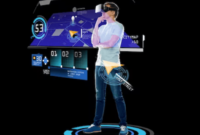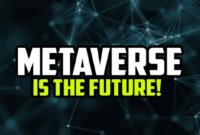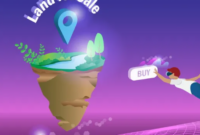bbc.towzdog.com – Creating Digital Art NFTs: A Complete Guide for Artists in 2024 The rise of Non-Fungible Tokens (NFTs) has transformed the way artists create, sell, and distribute their work. In particular, creating digital art NFTs has opened new avenues for artists to monetize their creativity in the digital age. This article will provide an in-depth look at the process of creating digital art NFTs, including current trends, tools, and best practices to help you navigate this exciting landscape in 2024.
What Are Digital Art NFTs?
Understanding NFTs
Non-Fungible Tokens (NFTs) are unique digital assets that represent ownership of a specific item or piece of content on a blockchain, most commonly Ethereum. Unlike cryptocurrencies such as Bitcoin, which are fungible and can be exchanged for one another, NFTs are unique and cannot be exchanged on a one-to-one basis. This uniqueness makes them ideal for digital art, music, collectibles, and other creative works.
The Importance of Digital Art NFTs
Creating digital art NFTs allows artists to maintain ownership of their work while providing a secure and verifiable way to sell it. Artists can benefit from direct sales to collectors, and some platforms even allow them to earn royalties from secondary sales, providing a sustainable income stream.
Getting Started with Creating Digital Art NFTs
1. Choose Your Digital Art Medium
Before diving into the NFT creation process, it’s essential to decide on the type of digital art you want to create. Some popular forms of digital art include:
- Digital Paintings: Traditional art techniques translated into digital format.
- 3D Models: Sculptures or objects created using software like Blender or ZBrush.
- Animations: Moving visuals that can tell a story or evoke emotions.
- Generative Art: Art created using algorithms and code, resulting in unique pieces.
2. Create Your Digital Artwork
Once you have chosen your medium, it’s time to create your artwork. Use digital art software such as:
- Adobe Photoshop: A versatile tool for creating digital paintings and graphic designs.
- Procreate: A popular app for iPad users that allows for intuitive drawing and painting.
- Blender: An open-source 3D modeling tool great for creating 3D art and animations.
- Processing: A programming language and environment for creating generative art.
3. Prepare Your Artwork for Minting
Before you can mint your artwork as an NFT, it needs to be in the right format. Common formats for digital art NFTs include:
- JPEG or PNG: Standard formats for images.
- GIF: For simple animations.
- MP4: For video files.
- GLB: For 3D models.
Ensure that your artwork is high quality and properly formatted to meet the specifications of the NFT platform you plan to use.
Minting Your Digital Art NFT
1. Choose an NFT Marketplace
The next step in creating digital art NFTs is selecting an appropriate NFT marketplace to mint and sell your artwork. Some of the leading platforms include:
- OpenSea: One of the largest NFT marketplaces that supports various digital assets.
- Rarible: A community-driven platform that allows artists to create and sell NFTs easily.
- Foundation: A curated platform focusing on high-quality digital art.
- Mintable: A user-friendly platform suitable for beginners looking to mint NFTs.
2. Set Up a Digital Wallet
To interact with NFT marketplaces, you’ll need a digital wallet that supports cryptocurrencies and NFTs. Popular wallets include:
- MetaMask: A widely used wallet that integrates with many NFT platforms.
- Coinbase Wallet: A secure option for managing cryptocurrencies and NFTs.
- Trust Wallet: A mobile wallet supporting various tokens and NFTs.
Once you’ve set up your wallet, you’ll need to purchase some Ethereum (ETH) to cover gas fees associated with minting your NFT.
3. Mint Your NFT
Minting your NFT involves uploading your artwork to the chosen platform and converting it into a token on the blockchain. Here’s a general process to follow:
- Connect Your Wallet: Link your digital wallet to the NFT marketplace.
- Upload Your Artwork: Follow the platform’s instructions to upload your digital art.
- Add Metadata: Include a title, description, and any other relevant information about your artwork. You may also want to include unlockable content, like a high-resolution file or a personal message to the buyer.
- Set Your Price: Decide whether to sell your NFT at a fixed price or through an auction.
- Mint the NFT: Confirm the transaction in your wallet and pay any associated gas fees to mint your NFT on the blockchain.
Marketing Your Digital Art NFT
1. Build Your Online Presence
To successfully sell your digital art NFTs, it’s essential to establish a strong online presence. Consider the following platforms:
- Social Media: Use platforms like Instagram, Twitter, and TikTok to showcase your art and connect with potential buyers.
- Art Communities: Join forums and communities such as DeviantArt, Behance, and ArtStation to network with other artists and collectors.
- Personal Website: Create a website or portfolio showcasing your art and links to your NFT listings.
2. Engage with the NFT Community
Engagement with the NFT community can significantly enhance your visibility as an artist. Participate in discussions on platforms like Discord, Clubhouse, or Reddit to share your work and connect with other creators and collectors.
3. Collaborate with Other Artists
Collaborations can help you reach new audiences. Partner with other artists or NFT creators to create joint projects or limited-edition collections that can attract attention and drive sales.
4. Utilize Online Auctions and Events
Participating in online auctions or showcasing your work during special events can create buzz around your NFTs. Platforms like Rarible and Foundation often host events that can help you gain visibility.
Current Trends in Digital Art NFTs (2024)
1. Increased Focus on Sustainability
As concerns about the environmental impact of blockchain technology grow, many artists and collectors are seeking more sustainable solutions. Platforms that use proof-of-stake systems, such as Tezos, are becoming more popular for minting NFTs due to their lower energy consumption.
2. Rise of Generative Art
Generative art, created through algorithms and coding, is gaining traction in the NFT space. Artists are increasingly leveraging programming languages to create unique and dynamic pieces that can only exist in digital form.
3. Emphasis on Community and Ownership
NFT collectors are placing a greater emphasis on community involvement and ownership rights. Many artists are exploring ways to give their collectors more than just a digital asset, such as access to exclusive content or events.
4. Integration with Virtual Reality
As the metaverse evolves, the integration of NFTs with virtual reality (VR) environments is becoming more prevalent. Artists are creating immersive experiences where collectors can showcase their digital art in virtual galleries or environments.
Conclusion
Creating digital art NFTs offers artists unprecedented opportunities to monetize their work and engage with a global audience. By following the steps outlined in this guide, you can navigate the process of creating, minting, and selling your digital art NFTs successfully.
As the NFT landscape continues to evolve, staying informed about trends and best practices will be crucial for success. For further insights and updates on the NFT space, visit CoinTelegraph.
Embrace the potential of digital art NFTs, connect with the community, and explore the exciting possibilities that await you in this dynamic digital frontier. Whether you’re a seasoned artist or just starting, the world of NFTs is full of opportunities to showcase your creativity and passion.




